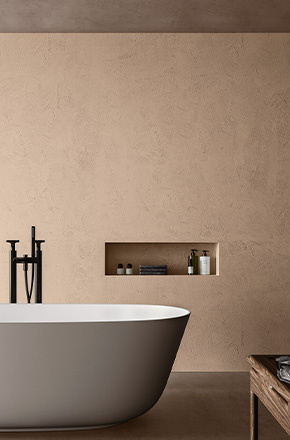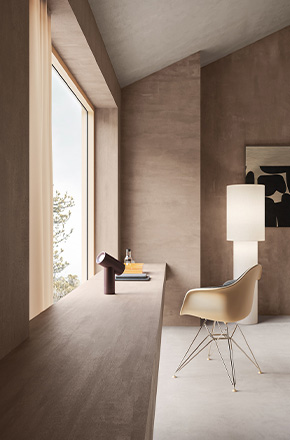Material effect: when surfaces speak. Lime textures as storytellers
Some materials build, some decorate, and others inspire. Lime, in its purest and most intentional form, does all of this at once, and quietly—with a soft, rough, subtle voice. A voice that doesn’t seek effect, but simply is. It is precisely in this material essence, in this vibrant and imperfect skin, that lime textures reveal themselves as one of the most refined and contemporary expressions of surface design.

Texture: a matter of reading
In architecture and interior design, texture does not simply signify “surface.” It also means narrative. It transforms a wall into a visual landscape, matter into gesture. Lime, with its mineral nature, its versatility in application, and its ability to absorb light, reflections, and pigments, becomes a true material grammar for those in search of authentic language.
Every application—trowel, brush, float—leaves a mark. Each layer adds a nuance, a ripple, a shadow. Lime doesn’t cover—it reveals. It offers a porous, vibrant surface that welcomes the eye and invites the touch. This is where the project goes beyond function and enters the realm of experience.

From buildings to spaces
In the Mediterranean context, lime has always been associated with light and time. Historically used for its protective and hygienic properties, it now attracts designers and architects for its emotional dimension.
It’s no longer a “neutral” finish, but an architectural skin with a story to tell. Trowelled, brushed, sanded or deliberately raw textures are not only aesthetic—they underlie an intention, the imprint of a design that chooses matter as its silent protagonist.
In contemporary spaces—where minimalism often risks fading into anonymity—decorative lime brings visual depth, enhances spatial perception, and introduces a sense of natural imperfection that balances the excess of industrial smoothness.
Imperfection as a mark of authenticity
The beauty of lime textures lies in what cannot be controlled. No surface will ever be identical to another; no finish can be replicated in a standardised way. This principle—once feared in the name of uniformity—is now celebrated as a value.
Lime surfaces become unique, unrepeatable, alive. This isn’t just about a “natural” aesthetic, but about a new way of thinking about design: slower, more mindful, more relational. The designer does not impose form but dialogues with matter. The artisan does not simply execute but interprets. And the wall becomes a place where gesture, composition, and space meet.

Light, depth, vibration
One of the least discussed—but most powerful—qualities of lime textures is their ability to react to light. Depending on the time of day, the angle of the light, and the colour temperature, the surface shifts, vibrates, comes to life.
Lime doesn’t just reflect light: it holds it, diffuses it, softens or enhances it, depending on the grain, the finish, and the layering. In complex architectural environments, this means bringing impactful walls to life—walls that accompany the space without dominating it, always leaving a subtle trace of their presence.

Handwork and matter: the centrality of craftsmanship
In a world of digital design and prefabrication, speaking of craftsmanship may seem countercultural. And yet, when working with lime, manual work regains its central role—not as nostalgia, but as a contemporary design act.
The artisan is not an executor but an interpreter, a director of matter. They know when to pause, where to apply pressure, how to modulate the hand. In this sense, lime textures are expressive codes born from a multi-layered composition: chemical, formal, and tactile intuition.
Lime and silence
In today’s visual language—often loud, overdecorated, or synthetic—lime offers a rare alternative: silence. A lime surface does not demand attention. It doesn’t shine, it doesn’t wink, it doesn’t flatter. But it’s there—and its presence suggests, welcomes, supports.
Its beauty doesn’t tire nor go out of fashion, as it doesn’t chase fashion. Lime creates surfaces that last, evolve, and allow themselves to be shaped by time. For this very reason, lime is more relevant today than ever before.